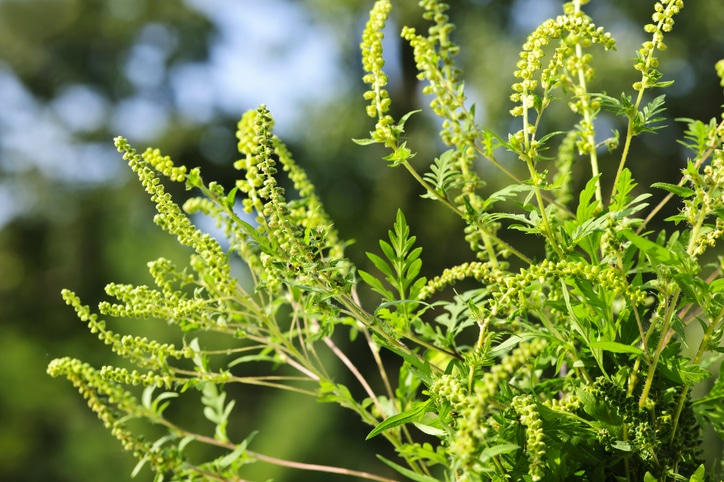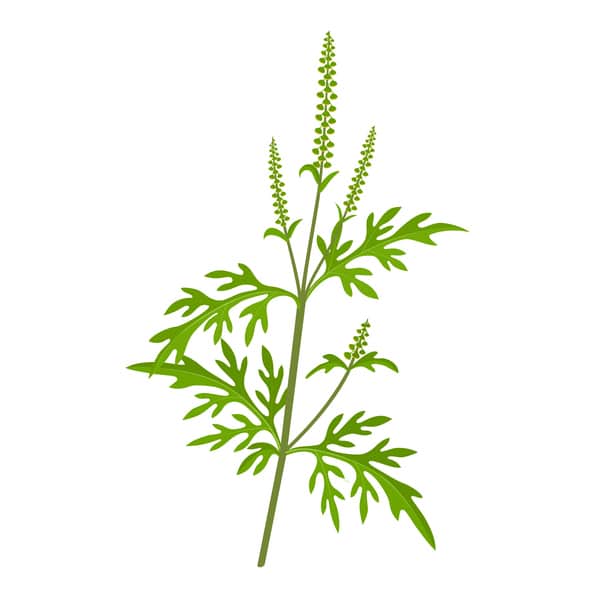Although the Willamette Valley is considered the grass seed capital of the world, weeds still play a major role for many allergy sufferers in Northern Oregon. Although it has improved over the years, ragweed, commonly found in the Midwest, still has a strong hold in the Willamette Valley and parts of Southwest Oregon.
That makes it an allergen contributor with a long, late pollen season—starting in early September, and thanks to recent increases in summer temperatures, lasting well into October.

Identifying Ragweed on Your Property
Offender: Ragweed
Genus: Ambrosia Artemisifolia
Aliases: Annual Ragweed, Bitterweed, Stammerwort, Tassleweed
What Does It Look Like?

Leaf patterns: Fern-like leaves. Spatula-shaped. Can have a similar appearance to broad-leaf parsley.
Stems: Thin. May be green or purple-tinted and covered in fine hair.
Flowers: Typically green or yellow, covering a lengthy stem.
Where Does Ragweed Like to Grow?
Ragweed is opportunistic and resilient, making it a tough weed, even among its peers. Some areas are independent of placement in your yard, where ragweed will take hold if possible.
- Sunny locations: Ragweed prefers full sun; you’re likely to find it in open areas of your yard outside of areas that receive full or partial shade.
- Areas with poor soil: Ragweed is tenacious. It doesn’t mind poor soil conditions and can thrive in compacted soil or even clay-rich soil.
- Disturbed soil: Although it can thrive in poor soil, it’s opportunistic. Given the opportunity, it will easily take root in sunny, disturbed soil, and each plant can produce between 30,000 and 60,000 seeds each.
Protect Yourself While Weeding
Hand-pulling is recommended to remove ragweed if you can safely do so without triggering a significant allergic reaction.
Ragweed can cause itchy, streaky red rashes 24 to 48 hours after exposure in individuals predisposed to ragweed allergens. These may be painful and form blisters, so always wear gloves while weeding and immediately launder clothes afterwards before washing off any additional outdoor contaminants.
What About Herbicides?
Herbicides are an option, but some ragweed varieties resist even broadleaf category-specific herbicides. These may not eliminate the problem and can kill other beneficial plants. If you use herbicides for ragweed, make sure to do so during mid-spring to early summer to target plants when their leaves are most susceptible to the effects of the herbicide.
Other Steps You Can Take
According to Heather Rhoades, recipient of the Master Gardeners of Ohio Lifetime Achievement Award, Ragweed doesn’t tolerate mowing well and adding compost and organic material to beds to improve their nutrient load and prevent heavy soil can act as preventative measures that keep ragweed from establishing.
Are You Allergic to Ragweed?
If you’re suffering from ragweed allergies, specialists with Willamette ENT & Facial Plastic Surgery can help. Ragweed allergies don’t typically improve on their own. Some allergy treatments may provide more than just symptom relief. Schedule today.
“I came to be under Dr. Donovan's care during a medical emergency at the hospital. The care I received that day and in every interaction after, at Willamette ENT has been prompt, professional and very thorough. I feel very well cared for.”